 username@email.com
username@email.com
In this lesson, you will review the characteristics and types of eukaryotes.
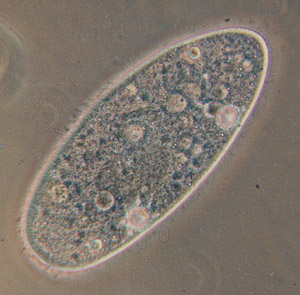
Eukaryotes are characterized by their membrane-bound nucleus and organelles, and the chromosomes that carry their DNA. The first eukaryotes, or protists, evolved about 1.5 billion years ago (for the previous 3 billion years, the world belonged to prokaryotes). The evolutionary step from prokaryotes to eukaryotes was one of the most revolutionary events in the biological history of the Earth.
One widely supported theory, the endosymbiotic theory, suggests that mitochondria were once free-living bacteria that had developed the ability to use oxygen to make ATP. This conferred such an evolutionary advantage, these bacteria thrived and eventually evolved into aerobic bacteria. It is believed that, over time, these ATP-producing organisms became incorporated into larger cells, perhaps through ingestion. A prokaryote that incorporates into itself an ATP-generating cell gains a definite energy, and evolutionary, advantage. Similarly, a large nonphotosynthetic prokaryote that ingests a photosynthetic prokaryote (a proto-chloroplast) also has a survival advantage. The fact that mitochondria have their own very prokaryote-like single-strand DNA and that their RNA and ribosomes closely resemble those of prokaryotes supports this theory further.
Single-celled eukaryotes are classified in the Kingdom Protista, which includes the algae, slime molds, and protozoa. The general characteristics of each group are shown in the following table.

Algae (singular, alga) are unicellular or simple multicellular organisms that carry out photosynthesis. It is likely that the six divisions of algae known today arose from a common ancestral eukaryotic cell. Three of the six divisions are made up mostly of unicellular organisms; the other three are mainly multicellular. The vast majority of algae are photosynthetic. Algae range in complexity from a single cell to a filament of cells to a solid body of cells that somewhat resembles, yet is not, a plant. The divisions of algae are based on the presence, number, and position of flagella; their pigmentation; and other factors, such as how they store food. The components of the algal cell wall, which often feels slimy due to its polysaccharides, also distinguish different algae.
Most single-celled algae occur on the surface of the ocean or freshwater bodies, where they are known as plankton. Unicellular algae are free-living autotrophs, though some may live in colonies. Multicellular algae occur primarily in shallow waters along shorelines. Divisions of algae have been named for the algae’s dominant pigment, which may hide the greening of the chloroplasts. Each Division is discussed and described below.
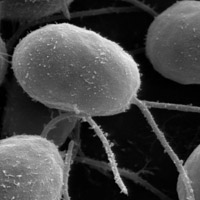
Green Algae
Division Euglenophyta consists of about 1,000 species of the endearing Euglena. These unicellular freshwater algae contain chloroplasts encased in a three-layer membrane, suggesting that Euglenas evolved by ingesting and incorporating green algae, which have a two-layer chloroplast membrane.
Euglenas are generally elongated, two-flagellum cells, with many chloroplasts that give the cell its striking emerald-green color. Euglenas have an “eye,” or photoreceptor, and too much light will send the cell “scurrying” from the spotlight. Euglenas are remarkable in that they may lead a “double life.” In sunlight, Euglenas are green and photosynthetic autotrophs; but put them in a dark closet, and they lose their color and become heterotrophs. Such Jekyll and Hyde behavior has led to scientific debate about whether Euglenas are algae or animals.
Division Chrysophyta includes the lovely diatoms (approximately 10,000 species), the golden-brown algae (approximately 1,500 species), and the smaller group (approximately 600 species) of yellow-green algae. Chrysophyta are characterized by the presence of chlorophylls a and c; fucoxanthin, a yellow-brown pigment present in all except the yellow-greens; silicon-impregnated cell walls (lacking cellulose); and their storage of food as oil rather than starch.
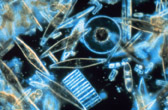
Diatom
Diatoms are famous for their beautiful, lace-like double shells made of rigid silicon. The tracery in the shells is actually pores that allow passage of materials into and out of the alga. Diatoms, like most plankton, are an important part of the marine food chain. Unlike their Divisional relatives, which reproduce via binary fission, diatoms sometimes reproduce sexually via a fusion of gametes, called syngamy.
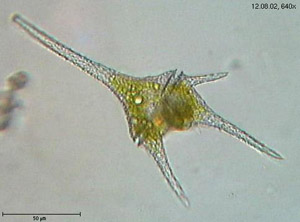
Dinoflagellates
Division Pyrrophyta, or fire algae, is made up of about 1,000 species of single-celled, marine dinoflagellates. Most species are photoautotrophs, but some are heterotrophs; most have two flagella. Dinoflagellates come in a bewilderingly weird variety of forms, kept in shape by rigid cellulose walls. A few are naked, and most of these are parasitic. As their name suggests, most fire algae are red. They are often the culprits in occurrences of toxic red tides. Some dinoflagellates (especially Gessnerium catenellum) that form red tides release neurotoxins, which have caused massive fish kills and occasional poisoning of humans who ingest it in filter-feeding mussels and other shellfish.
Division Chlorophyta contains the green algae, which may be either unicellular or multicellular. Chlorophyta are characterized by their chlorophylls a and b (as in plants), the presence of beta-carotene photosynthetic pigments, and their storage of food as starch. Most have cellulose in their cell walls. They are believed to be the ancestors of plants. Most green algae are freshwater organisms, although some are marine organisms; some of the 7,000 species in this Division live on tree trunks or in symbiosis with other organisms. The Chlorophyta are unique in that some species in this Division are multicellular. Scientists speculate that multicellularity may have arisen from this Division.
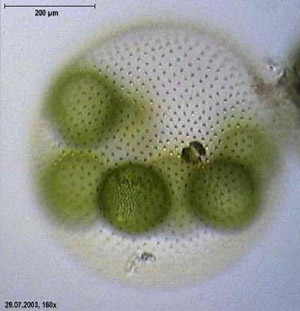
Volvox
Scientists believe that there are three pathways that lead from unicellularity to multicellularity. The first arose from colonies of single-celled organisms. A colony is a group of independently functioning single-celled organisms connected to each other via strands of cytoplasm. There are four genera of multicellular Chlorophytes. In order of complexity they are: Chlamydomonas, Gonium, Pandorina, and Volvox. Volvox is a hollow sphere whose single outer layer is comprised of as many as 60,000 minute flagellated cells.
The second path toward multicellularity is really an intermediate form of organization, referred to as coenocytic. In this case, a single organism consists of many nuclei in a common cytoplasm. Nuclear divisions are not accompanied by separation of the cytoplasm or the formation of cell walls. Coenocytic algae include the large Valonia and the filamentous Cladophora.
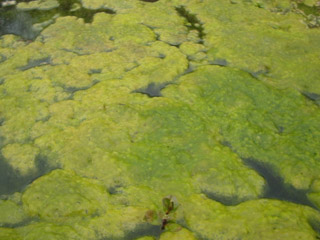
Spirogyra
The third road to multicellularity is represented by algae that undergo nuclear division as well as division of the cytoplasm and the formation of cell walls. Because of this type of cell division, these algae may occur in sheets, filaments, or even three-dimensional form. One green algae species that evinces this type of multicellularity is Spirogyra.
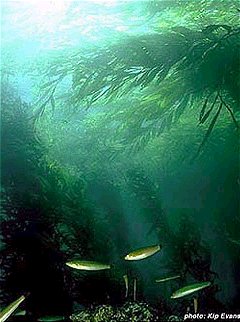
Kelp Forest
There are two Divisions that contain only multicellular algae. Division Phaeophyta consists of the brown algae – the seaweeds that thrive in cold marine waters. Kelps are members of this Division and occur, sometimes in huge forests, offshore in cooler climes. Many species occur along rocky shorelines, where their holdfasts, the kelp equivalent of roots, keep them anchored to the rocks and prevent them from being washed away by battering waves. The body of a multicellular alga is called a thallus, which consists of the holdfast, the stem-like stipe, and the leaf-like blade. Though these structures are likened to similar structures in plants, their internal organization is very different, and they resemble plant structures only superficially. The rockweed, Fucus, is a typical species in this Division.
The Division Rhodophyta, the red algae, consists of about 4,000 species of mostly tropical and subtropical marine seaweeds (very few species are freshwater). Their red color is conferred by the presence of phycobilins, and they also contain chlorophylls a and d, as well a carotenoids. Because of these pigments, Rhodophyta can survive at great depths, up to 175 meters below the surface. Some red algae have a slimy, mucilaginous outer layer, though others—the coralline algae—deposit calcium carbonate in their cell walls and are important in reef building.
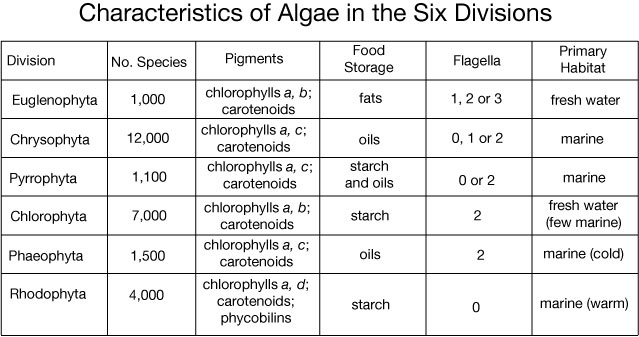
Eukaryotes are characterized by the presence of
The correct answer is C. Prokaryotes do not have organelles contained by membranes. Both prokaryotes and eukaryotes have plasma membranes, so A is not correct. Eukaryotes are not characterized by pili or flagella, as are prokaryotes, so B is incorrect. All cells have DNA, so D is not correct.
Unicellular algae that occur on or near the surface of water bodies are referred to as
The correct answer is B. Plankton consists of unicellular algae (phytoplankton) on the surface of water bodies. Some plankton is colonial, but this term does not refer to all surface-dwelling unicellular algae. Thus, A is not correct. Euglenas are one form of single-celled algae, so C is incorrect. Dinoflagellates are members of only one Division (Pyrrophyta) of algae, so D is not correct.
Which of the following is a form of multicellular algae?
The correct answer is D. Kelp are members of Division Phaeophyta, which contains only multicellular algae. Diatoms are unicellular algae with rigid silicon shells, so A is incorrect. Volvox are colonies of independent unicellular algae, so B is not correct. Chlorophyta is a Division of algae that includes both unicellular and multicellular algae, so C is not correct.